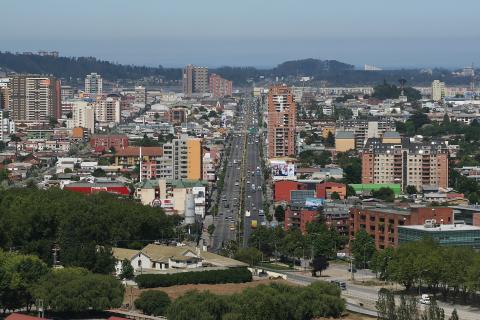Concepción, Chile

Concepcion City, Chile. © Shutterstock
Concepción lies in Central Chile, 500 kilometres south of the capital, Santiago. The city sits within the larger urban area of Greater Concepcion, where a population of 1,026,425 reside across 10 municipalities. As the 11th largest municipality in Chile, Concepción is home to 231,233 people. Located 10 kilometres upstream of the mouth of the river Biobio, the city is also a capital, major port, and important administrative hub for the wider Bio-Bio region.
Concepción was among the areas most severely impacted by the 2010 Chile earthquake. The 8.8 magnitude quake was followed by a devastating tsunami, which affected over 500 kilometres of the Chilean coast. Although extensive areas of the Greater Concepción coastline were destroyed in the event, high construction standards and strong enforcement of national construction codes were credited for low overall levels of damage to buildings.
Priority Areas for Intervention
Following the devastating events of 2010 the Municipalidad de Concepción, along with civil society and National Government, expressed a strong interest in measuring city resilience. With support from the Rockefeller Foundation, Arup is undertaking a series of pilot research studies in five global cities to test the feasibility, suitability and effectiveness of the City Resilience Index (CRI). Concepción was selected as an example of a Global South city that has undergone wide scale reconstruction and transformation following a major natural disaster. The CRI pilot offered the city the opportunity to evaluate strengths and weaknesses across the range of systems and processes which shape its resilience profile. The findings provided the city with a robust evidence base from which to identify future resilience-building activities, prioritise investment, and inform local policy change.
“As a city we must learn, prepare and know how to act in an emergency. We also need to understand that the preparation work before a tragedy must be made in advance. When we speak about resilience we believe it is the ability to stand up to a tragedy and learn from the mistakes we have made”.
- Alvaro Ortiz, Mayor of Concepcion, Chile
Examples of Resilience Building Efforts
The pilot assessment in Concepción brought together a diverse range of stakeholders from government, civil society and private sector. Some five years after the earthquake and tsunami, stakeholders identified a diverse range of interconnected stresses, which persist in the wake of the disaster. In particular, economic inequality has been strongly felt throughout the reconstruction and recovery process; characterised by unfair distribution of wealth and lack of quality access to basic services such as health, education, and housing.
“Resilience is the result of a culture that is permanently reinforced at all levels of the society. This is why it is important to measure it: so we know how well prepared we are”.
- Victor Orellana, Vice-Director, National Office of Emergencies, Chile
CRI pilot participants in Concepción agreed that the city has undergone significant transformation since the 2010 earthquake. Most public services have developed or improved emergency plans, while the National Emergency Office (ONEMI) has increased staff numbers by three-fold and launched a continuous 24-hour service. Several civil society-led initiatives were established in the last five years; such as Fundacion Alto Rio, a major civil-led initiative which aims to create a more resilient society through education, awareness, and disaster risk reduction.
“What and who makes a city resilient – and not just livable now or sustainable for the long term – has become an increasingly critical question, one we set out to answer with our partners at Arup through the creation of a City Resilience Index. Both the framework and the index are intended to facilitate a process of engagement with and within cities that generates dialogue and deeper understanding. Ultimately, this will lead to new ideas and opportunities to engage new actors in civil society, government and business on what makes a city resilient.”
- Nancy Kete, Managing Director for Resilience, The Rockefeller Foundation
Consultees also highlighted the importance of city participation as a foundation for building resilience. In the last year the City of Concepción has established a council of representatives of civil society (COSOC), which includes representatives from 28 local organisations. Stakeholders suggest that this initiative is a strong starting point for increasing civil involvement in policy making, though the city still has a long way to go in improving levels of engagement and participation.
Future Plans and Investments
Pilot fieldwork in Concepción demonstrates how measuring city performance across the 12 goals of the CRI can provide a strong basis for understanding urban resilience. Although many governmental agencies in Concepción have improved their capacity to respond to major disasters, a number of crucial challenges associated with deepening civil society participation in planning still remain. Participants in our pilot agreed that a holistic, collective approach to understanding and addressing urban resilience would constitute a significant step-change for the city.
Important themes that emerged from the Concepción pilot include the need for the municipality to restructure key policies and improve cross-departmental working. The assessment also catalysed discussions to improve data sharing practices between city departments and key collaborators, such as utility companies and regional authorities.
